This is quite a literal statement; there are a number of small insects that suck plant juices. This damage to the plant stresses them, often causing mottling or stippling, and is difficult to treat without insecticides. Let us delve in to the world of plant sucking insects.
Insect Mouthparts – Piercing/Sucking
There are a number of smaller insects that generally feed in large groups. These insects which are mostly true bugs and their cousins, use piercing-sucking mouthparts to feed. The congregate along plant stems and under leaves, and reproduce quickly.
This fall for instance, we are seeing a large number of whiteflies on shrubs and perennials. Whiteflies are closely related to aphids and use piercing-sucking mouthparts to feed on plants.
The following image shows how different insects feed with these mouthparts in the plant.
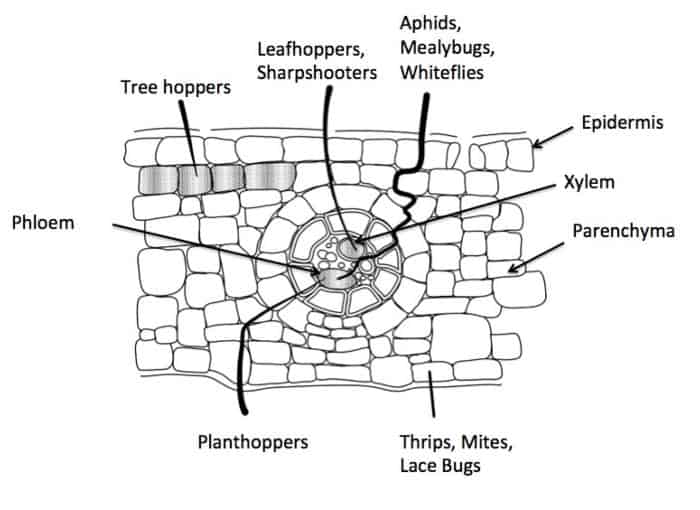
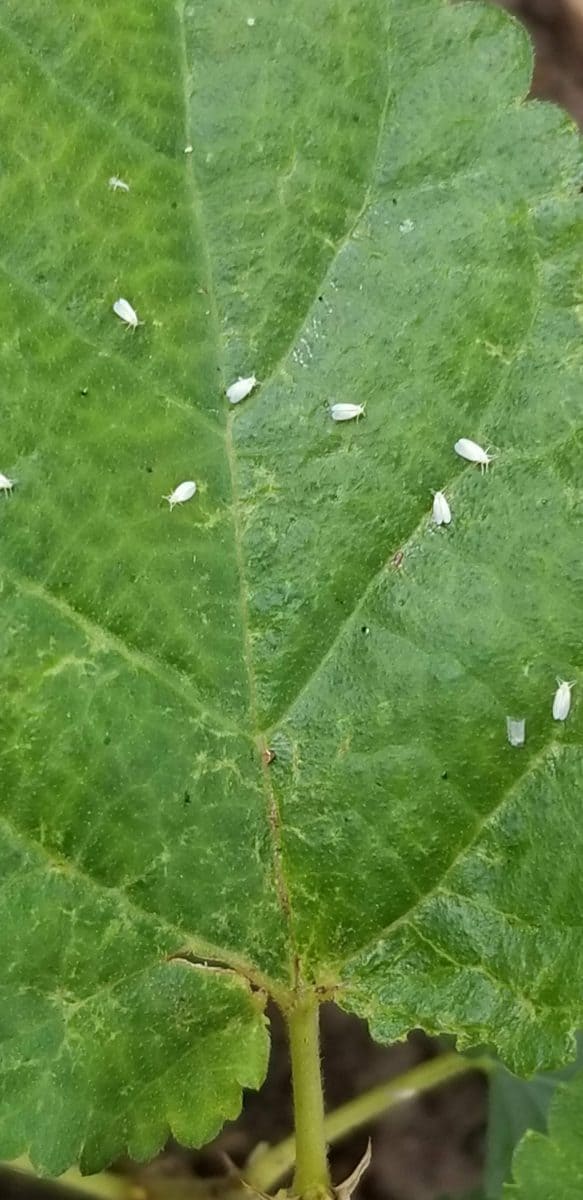
Whiteflies
These tiny white insects look like moths coming off the plant in large numbers. When working in the garden, I have found them to be in huge quantities this fall. Whiteflies are not flies, but members of the true bug group, known as Hemiptera. They are commonly a problem in houseplants, but can also affect landscape plants in dry autumns, such as we are having now in 2020.
Whiteflies overwinter as nymphs on susceptible host plants and then mature into adults in the spring. The adults lay several hundred eggs at a time, which hatch within 2 weeks. Both the adults and nymphs cause damage to the plant by sucking plant juices from the phloem. There are several generations per yer.
Because they feed on plant juices, they excrete honeydew like aphids, making plant undersides sticky. Besides feeding, they can transmit viruses to plants. This and their feeding damage weakens the plant, making it more susceptible to other diseases.
Lace Bugs
Another member of the true bug family, lace bugs are quite pretty if viewed under a microscope. But there damage can be very annoying and problematic for plants. Lace bugs are most commonly seen feeding on the undersides of tree leaves, such as oak. Bur oak is especially susceptible to them.
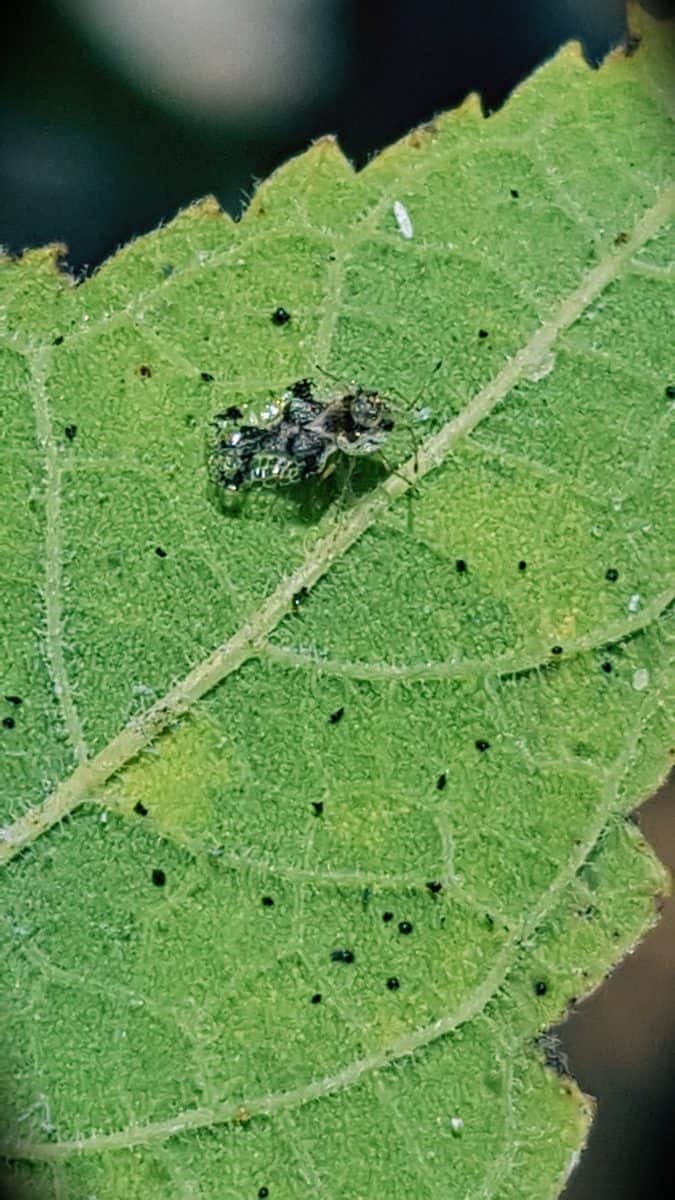
One of the worst infestations of lace bugs in the garden is actually on asters (symphyotrichum species). I often see them in the garden feeding on New England Aster (Symphyotrichum novae-angliae). Lace bugs cause mottling of the leaves and early leaf drop of the lower leaves (usually the bottom 1/2 of the plant).
Lace bugs are similar to whiteflies, in that they overwinter as nymphs and can have several generations per year on the plant.
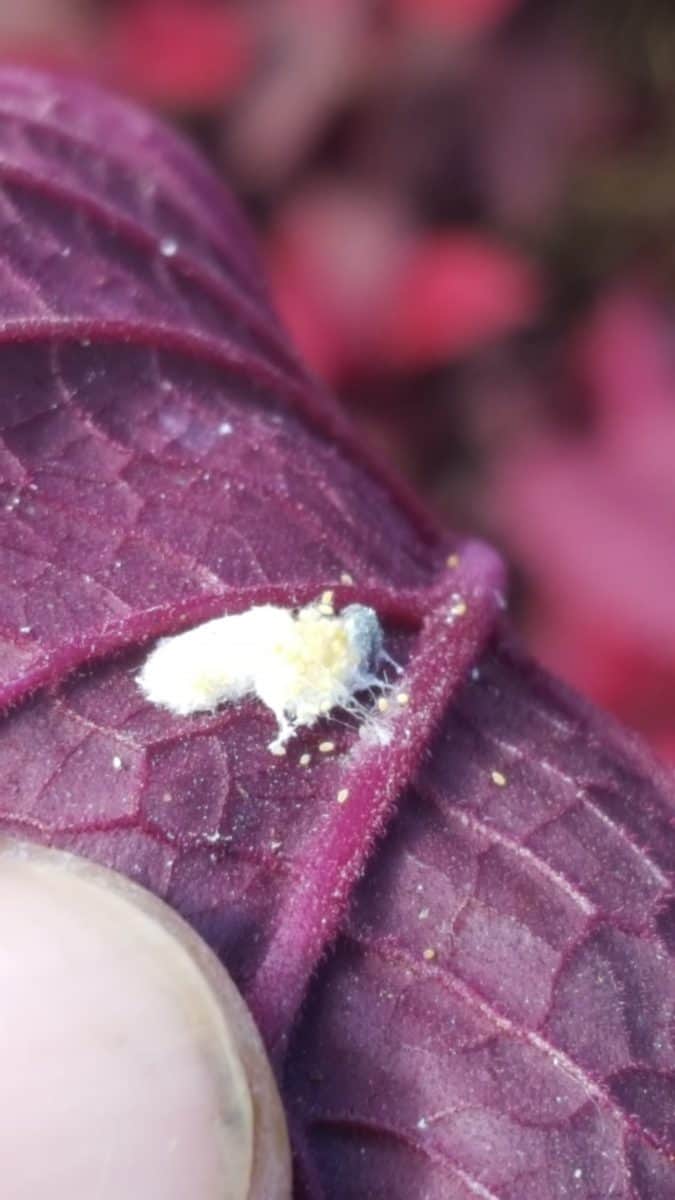
Mealybugs
Here at Grimm’s Gardens, we used to have the worst mealybug infestations in our greenhouses. Once we stopped overwintering plants in the houses and letting them freeze, we stopped having so much trouble with them.
Mealybugs can be very difficult to control, even with pesticides. Similar to scale insects, mealybugs grow a waxy exterior covering that repels most chemical applications. They lay 300-600 eggs in a white, cottony-looking mass with a waxy coating. These eggs hatch into small yellow nymphs that begin feeding immediately on the plant tissues.
They have 5 instars, where they shed their exoskeletons and grow hard, waxy coverings. When seen in masses on the plant they can be confused with powdery mildew. There are several generations a year.
Aphids
I have already delved deeply into aphids on another post, but I will say this. Aphids are a lot easier to treat that most people would suspect, since they are soft-bodied, and do not develop a waxy coating. They can be easily treated with soapy water or systemic insecticides.
Control/Treatment
Controlling the above sucking insects can be done in various ways. There are cultural and chemical practices that can be done to limit their damage.
Cultural Controls
Maintaining a healthy landscape through biodiversity of both plant and animal is one of the easiest ways to limit damage by insects. To maintain a healthy landscape, plant a variety of insect attracting and hosting plants, apply proper watering practices, limit the use of pesticides, and keep beds free from weeds and diseased plants.
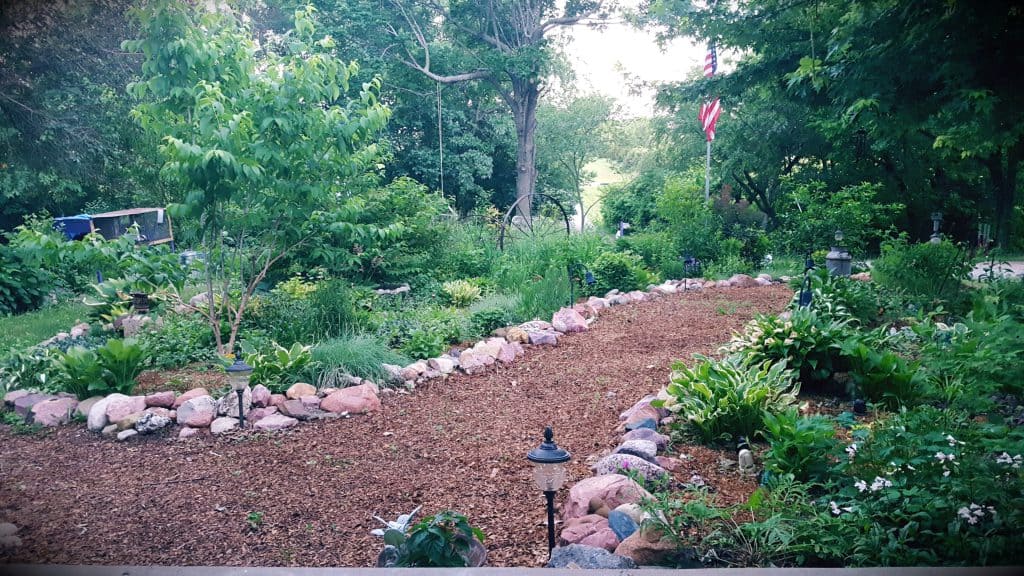
Attracting Beneficial Insects to the Garden
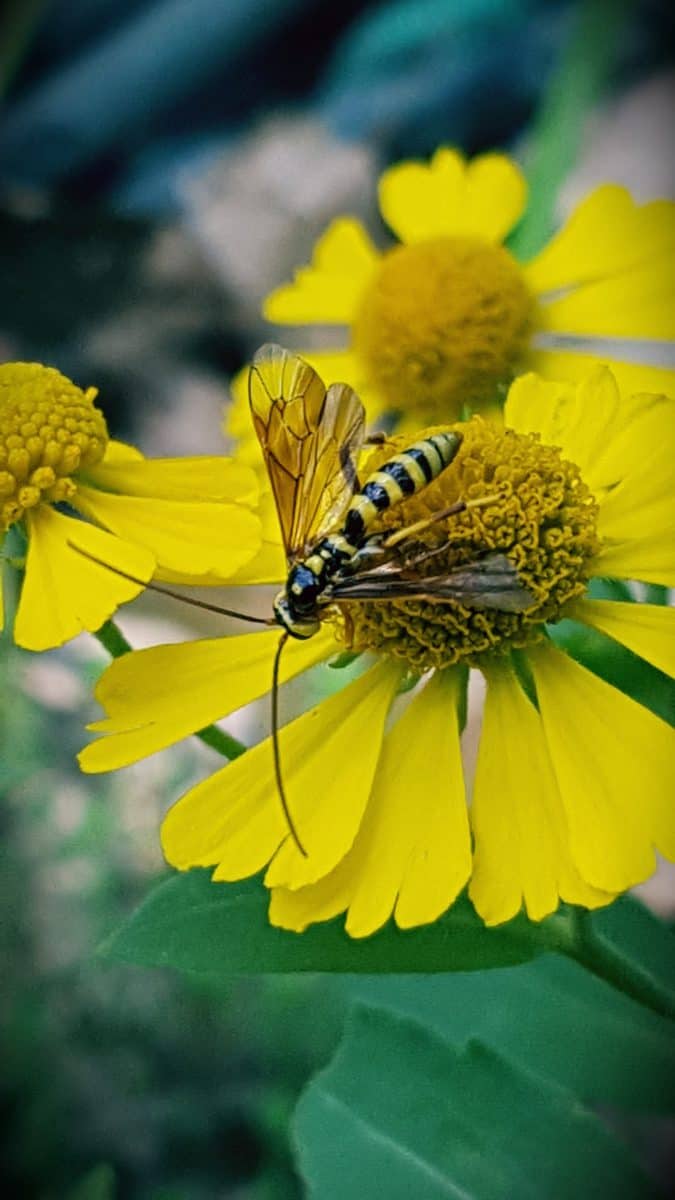
There are a variety of beneficial insects that feed on the above garden pests. These include lady beetles, lacewings, mealybug destroyers, minute pirate bugs, predatory midges, long-legged flies, hover flies, and parasitoid wasps.
Attract these insects by planting some of the following 12 plants:
- Dill
- Milkweeds
- Asters
- Mountain Mints
- Goldenrod
- Garlic Chives
- Tall Sedum
- Sneezeweed
- Yarrow
- Perennial or annual Sunflowers
- Echinacea
- Agastache
Keep the Garden Clean
Weeding is one of the gardener’s biggest chores, but it can help maintain a healthy landscape by removing hiding places for pests and potential plant diseases. Mulching is a good option to help keep weeds at bay, but having a garden with large leaf cover helps more.
Provide leaf cover to the garden by planting a greater amount of plants that shade the ground and grow closer together. Try to steer away from plants that are susceptible to powdery mildews (tall phlox, lilacs, older ninebarks) when doing this.
Also, be sure to remove any dead or diseased portions of plants as soon as possible, Clean out leaves in the fall and chop before adding them back into the landscape. This helps prevent overwintering insect larvae of pests.
Chemical Controls for Sucking Insects
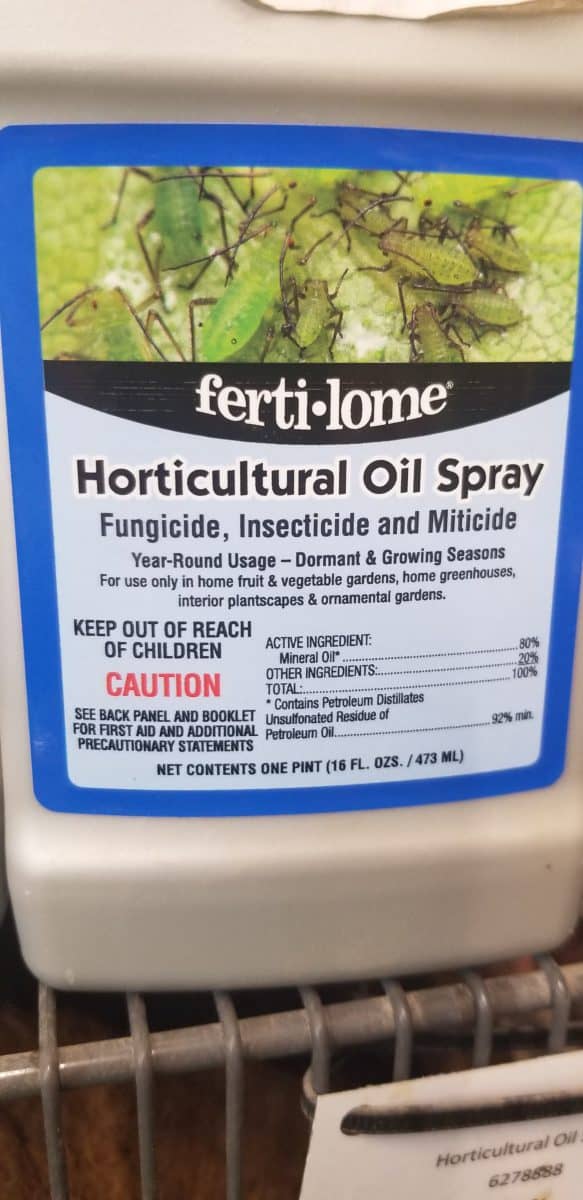
I always try to limit the use of chemical controls in my own landscape, as well as those of my customers. However, there are times when chemicals can be used safely for the benefit of the landscape.
Soaps and Oils
Aphids and whiteflies can be controlled at both the nymph and adult stages with the use of a simple soap and water mixture. Mix 1-2 tablespoons of dish soap per gallon of water and spray on the undersides of the plant or where the insects are. It is best to apply this on cloudy days or late in the evening, to prevent sun burn from the soap.
Horticultural oil can be applied during the nymph stage of mealybugs or scale. This oil suffocates the insects by clogging their breathing pores.
Systemic Insecticides
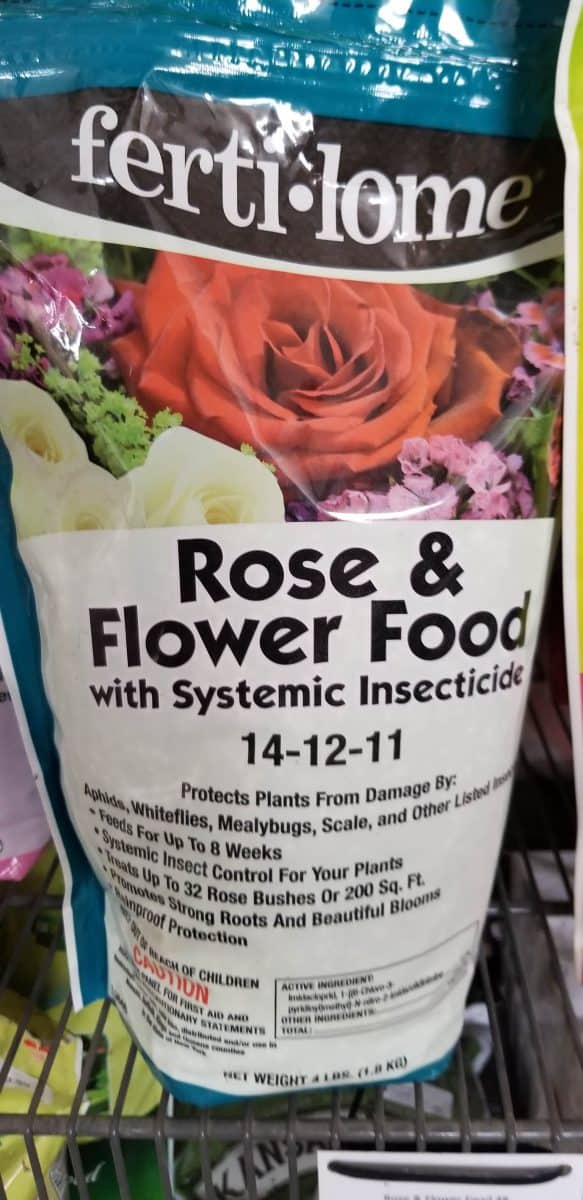
While the improper use of systemic insecticides can result in the death of both beneficials and pests, its proper use benefits the garden. I like to use Fertilome’s Rose and Flower Food plus Systemic, which contains imidicloprid. This chemical is translocated throughout the plants phloem and into the leaves, but does not accumulate in the flowers.
Systemic insecticides are great for plants that have problems with aphids, whiteflies, scale, and lacebugs. These plants include:
I have not found a systemic insecticide that effectively works on mealybugs. The best control for mealybugs is horticultural oil.
Conclusion
There are many types of plant sucking insects that I have not described here, including plant and leaf hoppers, spittlebugs, sharpshooters, and thrips. Look for a future post on the various planthoppers. We need to keep our plants healthy to help withstand an attack from insects that would seek to suck the life out f them.
Happy planting!

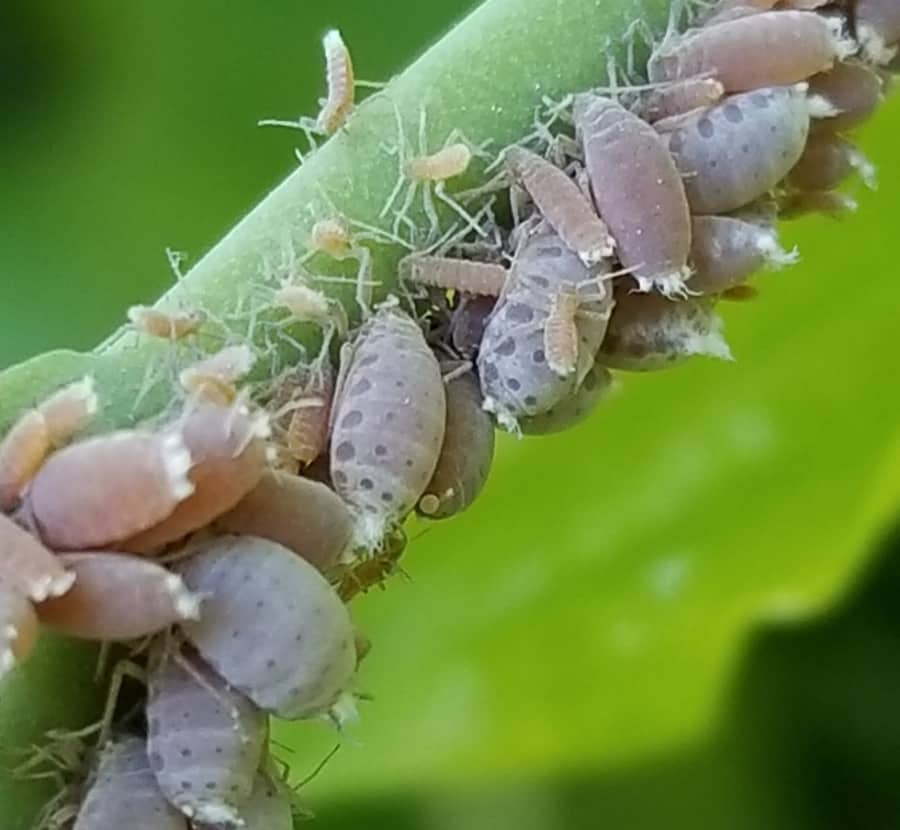



Hello. I have fuzzy insects at the base of a leaf where it connects on to the branch. (small skyflower tree). When I pick them off, they crumble easily when I squeeze them. Kind of sandy like. Would you be able to help with the name of this insect? I have pictures if that would help, I can attach them to an email. thank you.
Hi Mike, thank you for your question. Yes, I can do my best at identifying these insects by a photo. Please send photos to [email protected]
Good morning! A buddy of mine came across the insect in the picture at the top of this page. We are looking for a exact identification and this is the only similar photo i have found. Any more detail you have would be great! Thanks
Hi Adam, thank you for your interest! The insect in the photo on the top is the Woolly Maple Aphid (Neoprociphilus aceris), which is a common species on members of the Smilax Genus (greenbriers), which is the plant in the photo.
Thanks so much for your help!